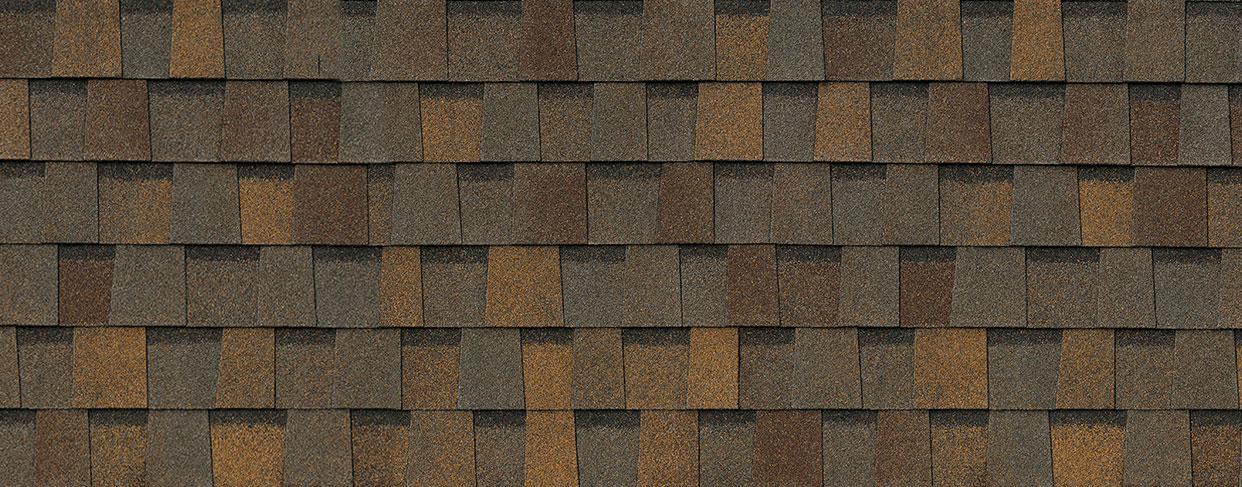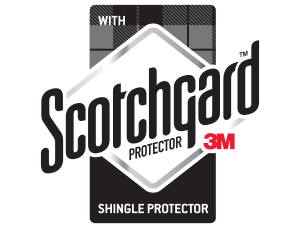PINNACLE

Pristine Appearance. Protected Appeal.


Pinnacle® Pristine shingles feature comprehensive warranty coverage for black streaks caused by algae, damage from high winds and manufacturer defects.
To provide homeowners the most accurate representation of color options, several photo scans and house shots were utilized in various lighting conditions. Variations in lighting illustrate the color gradients on asphalt shingle roofs.
Color blends vary from shingle to shingle. Before installation, consult with your contractor and request to view the actual shingles being installed on your roof to ensure confidence in your final color selection.
Color blends vary from shingle to shingle. Before installation, consult with your contractor and request to view the actual shingles being installed on your roof to ensure confidence in your final color selection.
FINAL COLOR SELECTIONS SHOULD BE MADE USING FULL SIZE SHINGLES. Colors and shadow lines on the sample board and in the photos should only be used as a guideline and not for your final color selection. Please consult your Atlas distributor for specific color and product availability. Due to national material shortages, all products may not be available in all areas. Please consult your Atlas contractor or distributor for specific color and product availability.
Product Features Include



Protect the investment in your home against severe weather with the Atlas 130 mph Wind Limited Warranty*.

Atlas shingles featuring Scotchgard™ Protector help prevent ugly black streaks caused by algae.

Your home is the biggest investment you will ever make. You want to protect that investment by using quality materials and the best installation practices.
Features
Demand Peak Coverage
For maximum protection and warranty coverage, install an Atlas Signature Select® Roofing System with components designed and backed by an Atlas Warranty.
Atlas WeatherMaster® Ice & Water Underlayment
Atlas Premium Underlayment
Atlas Pro-Cut® Starter Shingles
Atlas Roof Shingles
Atlas TruRidge® & HighPoint® Exhaust Ventilation
Atlas Pro-Cut® & StormMaster Hip & Ridge Shingles

Technical Information
Codes & Compliances
Length: 42″ / 1066.8 mm
Width: 14″ / 355.6 mm
Exposure: 6″ / 152.4 mm
56 Shingles per Square on Average
Algae Resistant: Scotchgard™ Protector
Wind Speed Limit**: 130 mph w/ 4 nails
Width: 14″ / 355.6 mm
Exposure: 6″ / 152.4 mm
56 Shingles per Square on Average
Algae Resistant: Scotchgard™ Protector
Wind Speed Limit**: 130 mph w/ 4 nails
ASTM
D7158, Class H Wind Resistance, Passed at 150 mph
D6381, Uplift Resistance
D3018, Type 1
D3161, Class F, Tested at 110 mph
D3462, As Manufactured
E108, Class A Fire Resistance
D6381, Uplift Resistance
D3018, Type 1
D3161, Class F, Tested at 110 mph
D3462, As Manufactured
E108, Class A Fire Resistance
UL
790, Class A Fire Resistance
2390, Class H Wind Resistance
CAN/CSA-A123.5-M90
Florida Building Code Approved – FL 16305
Miami-Dade County Product Control Approved, Miami-Dade County,
Florida, NOA No. 14-0115.01
2390, Class H Wind Resistance
CAN/CSA-A123.5-M90
Florida Building Code Approved – FL 16305
Miami-Dade County Product Control Approved, Miami-Dade County,
Florida, NOA No. 14-0115.01
Limited Warranty:
ATLAS ROOFING CORPORATION (“ATLAS”) warrants to you, the original owner of its shingle products, that this product is free from any manufacturing defects that materially affect the performance of your shingle during the Premium Protection Period or that cause leaks for the balance of the applicable warranty period.
ATLAS warrants that its shingles featuring Scotchgard™ Protector (those with the “featuring Scotchgard™ Protector” designation) will remain free of obvious and unsightly discoloration due to algae growth. For complete details, please see the Atlas Limited Shingle Warranty.
ATLAS warrants that its shingles featuring Scotchgard™ Protector (those with the “featuring Scotchgard™ Protector” designation) will remain free of obvious and unsightly discoloration due to algae growth. For complete details, please see the Atlas Limited Shingle Warranty.
Limited Warranty Period:
Your ATLAS shingles qualify for a limited warranty when properly installed in accordance with the product’s application instructions (as provided on the product packaging).
* In order to qualify for the Atlas Lifetime Algae Resistance Limited Warranty against black streaks caused by blue-green algae, installation must include Atlas Pro-Cut® Hip & Ridge shingles featuring Scotchgard™ Protector or Atlas Pro-Cut® High Profile Hip & Ridge shingles featuring Scotchgard™ Protector with Atlas shingles featuring Scotchgard™ Protector.
** Refer to the Atlas Roofing Limited Shingle Warranty for all coverage requirements.
* In order to qualify for the Atlas Lifetime Algae Resistance Limited Warranty against black streaks caused by blue-green algae, installation must include Atlas Pro-Cut® Hip & Ridge shingles featuring Scotchgard™ Protector or Atlas Pro-Cut® High Profile Hip & Ridge shingles featuring Scotchgard™ Protector with Atlas shingles featuring Scotchgard™ Protector.
** Refer to the Atlas Roofing Limited Shingle Warranty for all coverage requirements.
Installation Instructions:
PINNACLE PRISTINE GENERAL INSTRUCTIONS
IMPORTANT: THE STATEMENTS EXPRESSED ON THIS PAGE ARE THE RECOMMENDATIONS FOR THE APPLICATION OF THE ROOFING PRODUCTS AS OUTLINED AND ILLUSTRATED. ANY DEVIATION FROM THESE RECOMMENDED PROCEDURES SHALL BE AT THE SOLE RISK OF THE INSTALLERS. FAILURE TO FOLLOW THESE INSTRUCTIONS MAY RESULT IN SERIOUS DAMAGE TO THE APPLICATION AND LIFE OF THIS ROOFING PRODUCT, RESULTING IN THE TERMINATION OF ANY WARRANTY, EXPRESSED OR IMPLIED.
1.) GENERAL INSTRUCTIONS
The lifetime limited warranty option is only available for individual single-family site built detached residence. A 50 year limited warranty would apply to all property owned by government agencies, corporations, limited liability companies, partnerships, trusts, religious organizations, schools, or school districts, condominiums, or cooperative housing arrangements, or installed on apartment buildings or any type of building or premises not used by individual homeowners for a single family site built detached residence.
These shingles are warranted against manufacturing defects and wind gusts up to 130 MPH WITH STANDARD 4 NAIL INSTALLATION ONLY FOR SHINGLES WITH THE “BUILT WITH HP42 TECHNOLOGY DESIGNATION”.
The Pinnacle® Pristine Limited Warranty can be obtained by visiting www.AtlasRoofing.com/Warranty, or by writing to: Atlas Roofing Corporation, Attn: Consumer Services Department, 802 Hwy 19 N., Suite 170, Meridian, Mississippi, 39307. The following instructions must be followed to qualify for protection under the Pinnacle® Pristine Limited Warranty.
Important: See special instructions below for Low Slope Applications. See special instructions below for Steep Slope/Mansard/ 6-Nail application. To obtain stated area coverage and to achieve design performance and appearance, the directions on this package must be followed. Sealing of the adhesive strips on each shingle to the shingle beneath is created by heat from sunlight. Atlas Roofing Corporation also endorses the Asphalt Roofing Manufacturers Association’s (ARMA) recommendations for application details not specified within this text.
2.) ROOF DECK VENTILATION
Adequate ventilation under the roof deck must be provided to prevent harmful condensation in winter and heat build‐up in summer. These conditions can cause: A. Accelerated shingle weathering B. Deck rot and attic fungus C. Shingle distortion/ cracking due to deck movement D. Cosmetic blisters on the shingle surface. Atlas will not be responsible for damage to shingles as a result of inadequate ventilation. Ventilation provisions must meet or exceed current FHA Minimum Property Standards and conform to all building codes and regulations. To best ensure adequate ventilation and circulation of air, a combination of vents at the ridge and eaves should be used. All roof structures, especially mansard and cathedral type ceilings, must have complete through ventilation from eave area to the ridge area. FHA Minimum Property Standards require 1 square foot of net free attic vent area for every 150 square feet of attic floor area; or one square foot per every 300 square feet, if vapor barrier is installed on the warm side of the ceiling, or at least one half the ventilation area is provided near the ridge.
3.) ROOF DECK
These instructions are for the application of Atlas asphalt shingles to nominal 3/8” or 7/16” thick American Plywood Association (APA/TECO) rated, code approved plywood, OSB decks or minimum ¾” actual thickness, wood decking . The plywood or non-veneer (OSB) decks must comply with the roof deck specifications of APA/TECO. Solid wood decking must be well seasoned, not over 6″ (nominal) width, and fastened securely to each rafter. The deck surface must be clean, bare, gap free and flat. Pinnacle® Pristine shingles must not be applied to any surface other than roof deck types described here. Atlas also honors its Shingle Limited Warranty when Atlas shingles are installed on the Atlas CrossVent® Nailable Insulation panels. Atlas will not be responsible for the performance of its shingles if applied directly to non-vented, insulated decks composed of perlite board, plastic foam, fiberboard, gypsum plank, lightweight concrete, cementitious wood fiber, or similar materials or to any decks with insulation installed directly to the underside of the decking, with the exception of CrossVent® Nailable Insulation. Spray foam insulation applied directly to the bottom of the decking will void the warranty. Atlas shingles may be installed over a roof system containing a radiant barrier material if: 1. the required full, flow through ventilation is maintained directly under the decking material in all cases, 2. the radiant barrier material is highly vapor permeable ( > 2 perms), and, 3. the radiant barrier is installed on the underside of or below the decking – not used as an underlayment above the decking. Spray-‐on types of below deck vapor permeable radiant barriers will be considered only on a job by job basis, and only if tests confirm > 2 perms or greater vapor permeability.
4.) UNDERLAYMENT
Atlas highly recommends the use of high performance, ASTM 6757 compliant – Gorilla Guard® Everfelt™ or Summit® proprietary underlayment products for long term roof system performance and WeatherMaster® products self-adhering, waterproofing underlayment for critical areas, such as valleys and eaves. Atlas does not approve the use of any self-described, metalized or metal containing category of “Radiant Barrier”, as an asphalt shingle underlayment installed above the deck. Use of these types of radiant barrier would void the shingle warranty. Underlayment must be applied flat and unwrinkled. Building codes vary with geographic areas, and the installation must comply with local building codes or shingle manufacturer’s requirements, whichever is stricter. Shingles should be applied as soon as possible after the application of organic underlayment felt, which is not intended for prolonged exposure. Atlas recommends that the shingles be applied the same day as the felt underlayment application to avoid wetting and wrinkling. If an underlayment is used for prolonged dry-in, Atlas recommends Summit® Synthetic Underlayment as the dry-in underlayment, for up to 6 months exposure.
Standard Slope Application: Proper application requires that a single layer of approved underlayment be applied to decks with slopes 4:12 (> 18.4°) up to 21:12 (<60°) and consistent with all applicable building codes. This approved underlayment is a required roof assembly component to maintain a Class A fire rating of the deck assembly. Install underlayment over the entire deck, parallel to the eaves, overhanging 1/4" to 3/8", with fasteners placed 2" from the deck edge, 12" O.C. across the lower edge and with 2" overlap parallel to eaves and with 4" min. end lap, parallel to the rake. Underlayment end laps shall be staggered 6 feet apart from the adjacent courses. Corrosion-resistant drip edge should be placed over the underlayment at the rake and beneath the underlayment at the eaves.
Low Slope Application: 2:12 (>9.5°) up to 4:12 (<18.4°) (51mm/305mm) on slopes of 2" to 4" rise per foot, a double layer of approved underlayment over the entire deck surface is required. Atlas WeatherMaster Ice & Water products are highly recommended as the underlayment for low slope roofs to cover the entire deck prior to installing shingles. In low slope applications, slopes between 2:12 and 4:12, it is acceptable to install a single layer of WeatherMaster products either on partial or for entire deck coverage. As an alternative option, a double layer of approved underlayment can be installed over the entire deck surface is required. Starting with a 19" wide strip at eaves and overhanging the eaves 1/4" to 3/8", cover the first 19" course with a full 36" wide strip. Expose the first course 17" and continue up the deck with 36" wide strips, lapping each course 19" over the preceding course - providing a 17" exposure. End laps for low slopes shall be of at least 12" overlap and staggered 6 feet apart. Install drip edge over the underlayment at the rake and beneath the underlayment at the eaves.
5.) FLASHING
All flashing should be in place before shingles are installed. Cap flashings of sheet metal and base flashings of metal or mineral surfaced roll roofing should be used at vertical surfaces such as chimneys, skylights, vents, walls, etc. All flashings should be sealed with asphalt plastic cement. Consult the Residential Asphalt Roofing Manual published by the Asphalt Roofing Manufacturers Association (ARMA) for details concerning specific methods and types of flashing installation.
6.) ICE DAM PROTECTION
Eave and rake edge waterproof flashings must be installed per local building codes and where there is a possibility of icing along the eaves and rake edges causing a potential for ice damming and a backup of water. Atlas’s WeatherMaster® products, or equivalent must be applied directly over the decking according to application instructions provided with the product, and local building codes. The waterproof flashing material must extend up the roof at least 24″ beyond the interior warm wall line,
and in areas of severe icing, at least up to the highest water level expected to occur from ice dams. If the overhang requires flashing wider than 36″, the horizontal lap must be located on the overhang area and cemented or sealed. End laps must be 12″ (minimum) and cemented/sealed. WeatherMaster® products, as supplied by Atlas, are recommended as the first layer of Ice Dam Protection. WeatherMaster® products conform to ASTM D-‐1970.
7.) VALLEYS
Valleys must be installed before Pinnacle® Pristine shingles are applied.
Open Valley: Apply a 36″ ice & water product centered in the valley. Install 16″ wide minimum copper flashing (or equivalent) also centered in valley. Secure the copper flashing every 24″ along both edges either with copper cleats or large head copper nails with the shanks immediately adjacent to the copper edge. Overlaps in the copper must be a minimum of 12″.
Strike chalk lines on each side of the copper valley 3″ from the center line. As shingles are applied, trim them to chalk lines and, to direct water into valley, cut 2″ diagonally off upper corner of shingles adjacent to chalk line. Set valley edge of each shingle in a 3″ wide band of asphalt plastic cement meeting ASTM D-‐4586 and nail no closer than 6″ from valley center line. See Diagram #1.
Closed Cut Valley: Apply a 36″ wide ice & water product centered in the valley, nailing 2″ from outer edges only. Apply all shingles on one side of valley and across center of valley, a minimum of 12″. Nail a minimum of 6″ away from the center line of the valley on the unshingled side and strike a chalk line 2″ from the center line on the un-‐shingled side. Apply shingles on the unshingled side up to the chalk line and trim. Do not cut the underlying shingle.
Cut upper corners of the shingle, cement and nail. See Diagram #2.

8.) FASTENING
Placement of nails is critical to overall performance. High nail placement can result in separation of components and will cause delamination of the shingles after application. All nails must be driven straight with the heads flush to the shingle surface, never cutting into the shingle. Nails must not be exposed (visible) on the finished roof. Delamination after installation does not justify a warranty claim.
FASTENERS: Nails must be 11 OR 12 gauge corrosion-resistant roofing nails with 3/8″ minimum head. Nails must be long enough to penetrate the roof deck 3/4″ or if the deck is less than 3/4″ thick, the nails should be long enough to penetrate fully and extend at least 1/8″ through the roof deck. Nails may be placed in the sealant line.
NEW ROOFING APPLICATION (first shingle layer): 4 nails are required per shingle. The nails are to be located 7″ up from the bottom edge of the shingle, with one nail placed approximately 1″ from each side of the shingle, and the remaining two equally spaced between the two outer nails as illustrated in the diagram. NAILS MUST BE MINIMUM OF 1-1/4″ LONG. See Diagram #3.
RE-ROOFING APPLICATION (second shingle layer): Requires the same nail placement as New Roofing. NAIL PLACEMENT IS IMPORTANT FOR WIND RESISTANCE. INCORRECTLY PLACED NAILS WILL VOID WIND COVERAGE OF WARRANTY. (See Section #12)
9.) APPLICATION
Prepare deck with an approved roof underlayment, drip edges and flashings as recommended. Horizontal and vertical chalk lines should be utilized to ensure proper shingle alignment from eave to ridge.
Starter Course: Use PRO-CUT® STARTER SHINGLE. (Pro-Cut Starter Shingles are REQUIRED for the Signature Select Roofing System) or 3‐tab shingle for the starter course (if your roof is NOT qualifying for the Signature Select Roofing System). Trim off tabs and apply with 1/4″ to 3/4″ overhang on the eaves. Note the seal‐down feature should be in line with the eave. In order to offset seams, cut 6″ off the left end of the first shingle. Begin application at lower left rake of roof, and then continue across with full-length shingle, nailed with 4 nails equally spaced across the shingle and nailed 3″ up from the eave. See Diagram #4.
Standard Slope Application: Proper application requires that a single layer of approved underlayment be applied to decks with slopes 4:12 (> 18.4°) up to 21:12 (<60°) and consistent with all applicable building codes. This approved underlayment is a required roof assembly component to maintain a Class A fire rating of the deck assembly. Install underlayment over the entire deck, parallel to the eaves, overhanging 1/4" to 3/8", with fasteners placed 2" from the deck edge, 12" O.C. across the lower edge and with 2" overlap parallel to eaves and with 4" min. end lap, parallel to the rake. Underlayment end laps shall be staggered 6 feet apart from the adjacent courses. Corrosion-resistant drip edge should be placed over the underlayment at the rake and beneath the underlayment at the eaves.
Low Slope Application: 2:12 (>9.5°) up to 4:12 (<18.4°) (51mm/305mm) on slopes of 2" to 4" rise per foot, a double layer of approved underlayment over the entire deck surface is required. Atlas WeatherMaster Ice & Water products are highly recommended as the underlayment for low slope roofs to cover the entire deck prior to installing shingles. In low slope applications, slopes between 2:12 and 4:12, it is acceptable to install a single layer of WeatherMaster products either on partial or for entire deck coverage. As an alternative option, a double layer of approved underlayment can be installed over the entire deck surface is required. Starting with a 19" wide strip at eaves and overhanging the eaves 1/4" to 3/8", cover the first 19" course with a full 36" wide strip. Expose the first course 17" and continue up the deck with 36" wide strips, lapping each course 19" over the preceding course - providing a 17" exposure. End laps for low slopes shall be of at least 12" overlap and staggered 6 feet apart. Install drip edge over the underlayment at the rake and beneath the underlayment at the eaves.
5.) FLASHING
All flashing should be in place before shingles are installed. Cap flashings of sheet metal and base flashings of metal or mineral surfaced roll roofing should be used at vertical surfaces such as chimneys, skylights, vents, walls, etc. All flashings should be sealed with asphalt plastic cement. Consult the Residential Asphalt Roofing Manual published by the Asphalt Roofing Manufacturers Association (ARMA) for details concerning specific methods and types of flashing installation.
6.) ICE DAM PROTECTION
Eave and rake edge waterproof flashings must be installed per local building codes and where there is a possibility of icing along the eaves and rake edges causing a potential for ice damming and a backup of water. Atlas’s WeatherMaster® products, or equivalent must be applied directly over the decking according to application instructions provided with the product, and local building codes. The waterproof flashing material must extend up the roof at least 24″ beyond the interior warm wall line,
and in areas of severe icing, at least up to the highest water level expected to occur from ice dams. If the overhang requires flashing wider than 36″, the horizontal lap must be located on the overhang area and cemented or sealed. End laps must be 12″ (minimum) and cemented/sealed. WeatherMaster® products, as supplied by Atlas, are recommended as the first layer of Ice Dam Protection. WeatherMaster® products conform to ASTM D-‐1970.
7.) VALLEYS
Valleys must be installed before Pinnacle® Pristine shingles are applied.
Open Valley: Apply a 36″ ice & water product centered in the valley. Install 16″ wide minimum copper flashing (or equivalent) also centered in valley. Secure the copper flashing every 24″ along both edges either with copper cleats or large head copper nails with the shanks immediately adjacent to the copper edge. Overlaps in the copper must be a minimum of 12″.
Strike chalk lines on each side of the copper valley 3″ from the center line. As shingles are applied, trim them to chalk lines and, to direct water into valley, cut 2″ diagonally off upper corner of shingles adjacent to chalk line. Set valley edge of each shingle in a 3″ wide band of asphalt plastic cement meeting ASTM D-‐4586 and nail no closer than 6″ from valley center line. See Diagram #1.
Closed Cut Valley: Apply a 36″ wide ice & water product centered in the valley, nailing 2″ from outer edges only. Apply all shingles on one side of valley and across center of valley, a minimum of 12″. Nail a minimum of 6″ away from the center line of the valley on the unshingled side and strike a chalk line 2″ from the center line on the un-‐shingled side. Apply shingles on the unshingled side up to the chalk line and trim. Do not cut the underlying shingle.
Cut upper corners of the shingle, cement and nail. See Diagram #2.

8.) FASTENING
Placement of nails is critical to overall performance. High nail placement can result in separation of components and will cause delamination of the shingles after application. All nails must be driven straight with the heads flush to the shingle surface, never cutting into the shingle. Nails must not be exposed (visible) on the finished roof. Delamination after installation does not justify a warranty claim.
FASTENERS: Nails must be 11 OR 12 gauge corrosion-resistant roofing nails with 3/8″ minimum head. Nails must be long enough to penetrate the roof deck 3/4″ or if the deck is less than 3/4″ thick, the nails should be long enough to penetrate fully and extend at least 1/8″ through the roof deck. Nails may be placed in the sealant line.
NEW ROOFING APPLICATION (first shingle layer): 4 nails are required per shingle. The nails are to be located 7″ up from the bottom edge of the shingle, with one nail placed approximately 1″ from each side of the shingle, and the remaining two equally spaced between the two outer nails as illustrated in the diagram. NAILS MUST BE MINIMUM OF 1-1/4″ LONG. See Diagram #3.
RE-ROOFING APPLICATION (second shingle layer): Requires the same nail placement as New Roofing. NAIL PLACEMENT IS IMPORTANT FOR WIND RESISTANCE. INCORRECTLY PLACED NAILS WILL VOID WIND COVERAGE OF WARRANTY. (See Section #12)
9.) APPLICATION
Prepare deck with an approved roof underlayment, drip edges and flashings as recommended. Horizontal and vertical chalk lines should be utilized to ensure proper shingle alignment from eave to ridge.
Starter Course: Use PRO-CUT® STARTER SHINGLE. (Pro-Cut Starter Shingles are REQUIRED for the Signature Select Roofing System) or 3‐tab shingle for the starter course (if your roof is NOT qualifying for the Signature Select Roofing System). Trim off tabs and apply with 1/4″ to 3/4″ overhang on the eaves. Note the seal‐down feature should be in line with the eave. In order to offset seams, cut 6″ off the left end of the first shingle. Begin application at lower left rake of roof, and then continue across with full-length shingle, nailed with 4 nails equally spaced across the shingle and nailed 3″ up from the eave. See Diagram #4.
Install Starter At All Rakes And Eaves For Proper Shingle Seal Down

1½” Sweet Spot Nailing Area; 6″ Exposure

1½” Sweet Spot Nailing Area; 6″ Exposure


